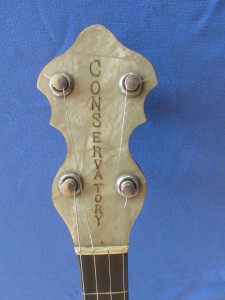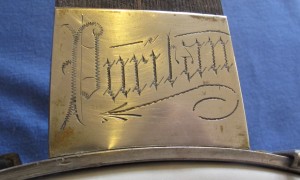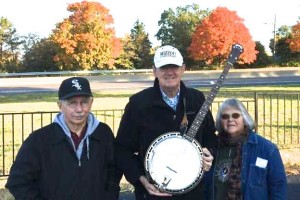Not infrequently, musicians will drop-off old dusty mystery banjos for study and/or comments at the BRC, and sometimes the instruments are left there forever. An antique “Conservatory” 4-stringer recently appeared in our shop featuring a peg head surfaced with so-called pearloid.
This primitive plastic was first synthesized in the late 1860`s by swirling pieces of celluloid (nitrocellulose) in a solvent and letting it cure into a solid mimicking mother of pearl. The material was first used to make attractive ivory-like knife handles in the 1870`s, and by the 1920`s it decorated drum rims. Gibson began using it to inexpensively ornament guitars in the 1930`s. Since then, the glimmering imitation pearl has earned the waggish title “mother of toilet seat” and is also known by the acronym MOTS.
Not too long ago, an otherwise unmarked 5-stringer with a brass “Puritan” plaque at the base of the fretboard was left-off at the BRC for an estimation of its date of manufacture.

The banjo proved to be built circa 1895 as confirmed by a search in the “Encyclopedia of American Fretted Instruments, pre-Civil War to WW 2” on the <mugwumps.com> website. This impressive anthology of over 1800 stringed instrument builders and their brand names was a work-of-love by the late Mike Holmes, an archivist of folk music instruments.
 At a recent Farmer`s Market surrounded by flame-colored autumnal foliage, a plucky trio of Bluegrass musicians bravely huddle-up in late Fall chilly temperatures to entertain shoppers with archival, if not ancient, old time music. Tips went to the Children’s Hospital.
At a recent Farmer`s Market surrounded by flame-colored autumnal foliage, a plucky trio of Bluegrass musicians bravely huddle-up in late Fall chilly temperatures to entertain shoppers with archival, if not ancient, old time music. Tips went to the Children’s Hospital.

No Comments